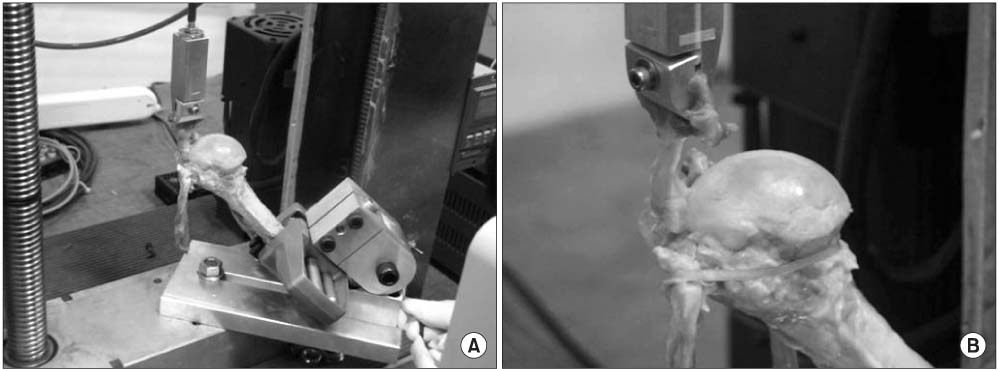J Korean Orthop Assoc.
2010 Apr;45(2):120-126. 10.4055/jkoa.2010.45.2.120.
Biomechanical Comparison of the Modified ML (Mattress Locking) Suture and the Modified MA (Mason-Allen) Suture in Rotator Cuff Repairs
- Affiliations
-
- 1Department of Orthopedic Surgery, Arthro-center, Ulsan University Hospital, University of Ulsan College of Medicine, Ulsan, Korea. shkoshko@yahoo.co.kr
- 2School of Mechanical and Automotive Engineering University of Ulsan, Ulsan, Korea.
- KMID: 2185579
- DOI: http://doi.org/10.4055/jkoa.2010.45.2.120
Abstract
- PURPOSE
In arthroscopic rotator cuff repairs, there is generally a weak link in the tendon suture interface, and arthroscopic rotator cuff repairs can have higher retear rates than open repairs. The purpose of this study was to compare the strength of modified ML (Mattress Locking) suture vs. the modified MA (Mason-Allen) suture when the suture is anchored into bone.
MATERIALS AND METHODS
Paired human supraspinatus tendons were harvested and split in half, producing four tendons per one cadaver, for a total of 24 specimens. Two suture configurations (ML, MA) were randomized and checked for each set of tendons. Specimens were cyclically loaded under force control between 5 and 30 N at 0.25 Hz for fifty cycles. Each specimen was loaded to failure under displacement control at 1 mm/sec. Cyclic elongation, peak to peak displacement, stiffness, ultimate tensile load, and mode of failure were checked.
RESULTS
No significant difference was found between the two suture configuration with respect to peak to peak displacement, cyclic elongation, and stiffness. With regard to ultimate failure load, there were no statistically significant differences between the modified ML suture and the modified MA suture (223.18N, 220.82N). The most common mode of failure between both sutures was suture pullout.
CONCLUSION
The modified ML suture and the modified MA suture have similar biomechanical properties. The modified ML suture may be a simple and clever method and similar biomechanical alternative to the modified Mason-Allen suture in arthroscopic rotator cuff repair.
MeSH Terms
Figure
Reference
-
1. Ko SH, Cho SD, Choe SW, et al. The evaluation for the usefulness of arthroscopic miniopen repair which related with large and massive sized full-thickness rotator cuff tear and clinical results. J Korean Shoulder Elbow Soc. 2006. 9:83–88.2. Ko SH, Cho SD, Gwak CY, Eo J, Yoo CH, Choe SW. Use of massive cuff stitch in arthroscopic repair of rotator cuff tears. J Korean Shoulder Elbow Soc. 2006. 9:181–188.
Article3. Ko SH, Cho SD, Lew SU, Park MS, Kwag CY, Woo JK. Comparison of arthroscopic versus mini open repair in medium and large sized full thickness rotator cuff tear -short term preliminary results-. J Korean Orthop Sports Med. 2004. 3:73–80.4. Ko SH, Cho SD, Ryu SO, Gwak CY, Park MS. Arthroscopic repair of full thickness rotator cuff tear. J Korean Shoulder Elbow Soc. 2003. 6:161–166.5. Ko SH, Lee CC, Rhee YG, Jeon HM. The usefulness of all arthroscopic repair with biceps incorporation in massive sized full thickness rotator cuff tears. J Korean Shoulder Elbow Soc. 2007. 10:106–111.6. Ma CB, Comerford L, Wilson J, Puttlitz CM. Biomechanical evaluation of arthroscopic rotator cuff repairs: double-row compared with single-row fixation. J Bone Joint Surg Am. 2006. 88:403–410.7. Sileo MJ, Ruotolo CR, Nelson CO, Serra-Hsu F, Panchal AP. A biomechanical comparison of the modified Mason-Allen stitch and massive cuff sitich in vitro. Arthroscopy. 2007. 23:235–240.8. Cummins CA, Murrell GA. Mode of failure for rotator cuff repair with suture anchors identified at revision surgery. J Shoulder Elbow Surg. 2003. 12:128–133.
Article9. Gerber C, Schneeberger AG, Perren SM, Nyffeler RW. Experimental rotator cuff repair. A preliminary study. J Bone Joint Surg Am. 1999. 81:1281–1290.
Article10. Gerber C, Schneeberger AG, Beck M, Schlegel U. Mechanical strength of repairs of the rotator cuff. J Bone Joint Surg Br. 1994. 76:371–380.
Article11. Schneeberger AG, von Roll A, Kalberer F, Jacob HA, Gerber C. Mechanical strength of arthroscopic rotator cuff repair techniques: an in vitro study. J Bone Joint Surg Am. 2002. 84:2152–2160.12. Galatz LM, Ball CM, Teefey SA, Middleton WD, Yamaguchi K. The outcome and repair integrity of completely arthroscopically repaired large and massive rotator cuff tears. J Bone Joint Surg Am. 2004. 86-A:219–224.
Article13. MacGillivray JD, Ma CB. An arthroscopic stitch for massive rotator cuff tears: the Mac stitch. Arthroscopy. 2004. 20:669–671.
Article14. Ma CB, MacGillivray JD, Clabeaux J, Lee S, Otis JC. Biomechanical evaluation of arthroscopic rotator cuff stitches. J Bone Joint Surg Am. 2004. 86:1211–1216.
Article15. Scheibel MT, Habermeyer P. A modified Mason-Allen technique for rotator cuff repair using suture anchors. Arthroscopy. 2003. 19:330–333.
Article16. Ko SH, Lee CC, Friedman D, Park KB, Warner JJ. Arthroscopic single-row supraspinatus tendon repair with a modified mattress locking stitch: a prospective randomized controlled comparison with a simple stitch. Arthroscopy. 2008. 24:1005–1012.
Article
- Full Text Links
- Actions
-
Cited
- CITED
-
- Close
- Share
- Similar articles
-
- Modified Mason-Allen Suture Bridge Technique: A New Suture Bridge Technique with Improved Tissue Holding by the Modified Mason-Allen Stitch
- Is the UU Stitch Really Alternative to Modified MA (Mason-Allen) Stitch for Rotator Cuff Repair?: Biomechanical Comparative Study of UU to Modified MA Stitch
- New Method and Clinical Results of Arthroscopic Mattress-Locking Suture for Small and Medium sized Rotator Cuff Tear
- All Arthroscopic Repairs with Massive Cuff Stitch in Medium-sized Full Thickness Rotator Cuff Tears
- Delayed Lateral Row Anchor Failure in Suture Bridge Rotator Cuff Repair: A Report of 3 Cases




